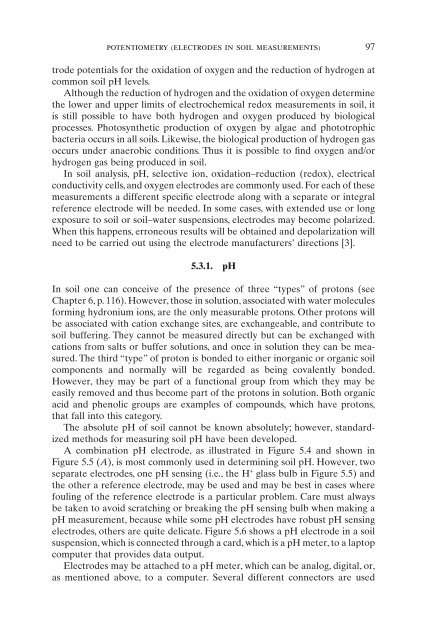Introduction to Soil Chemistry
Introduction to Soil Chemistry
Introduction to Soil Chemistry
Create successful ePaper yourself
Turn your PDF publications into a flip-book with our unique Google optimized e-Paper software.
potentiometry (electrodes in soil measurements) 97<br />
trode potentials for the oxidation of oxygen and the reduction of hydrogen at<br />
common soil pH levels.<br />
Although the reduction of hydrogen and the oxidation of oxygen determine<br />
the lower and upper limits of electrochemical redox measurements in soil, it<br />
is still possible <strong>to</strong> have both hydrogen and oxygen produced by biological<br />
processes. Pho<strong>to</strong>synthetic production of oxygen by algae and pho<strong>to</strong>trophic<br />
bacteria occurs in all soils. Likewise, the biological production of hydrogen gas<br />
occurs under anaerobic conditions. Thus it is possible <strong>to</strong> find oxygen and/or<br />
hydrogen gas being produced in soil.<br />
In soil analysis, pH, selective ion, oxidation–reduction (redox), electrical<br />
conductivity cells, and oxygen electrodes are commonly used. For each of these<br />
measurements a different specific electrode along with a separate or integral<br />
reference electrode will be needed. In some cases, with extended use or long<br />
exposure <strong>to</strong> soil or soil–water suspensions, electrodes may become polarized.<br />
When this happens, erroneous results will be obtained and depolarization will<br />
need <strong>to</strong> be carried out using the electrode manufacturers’ directions [3].<br />
5.3.1. pH<br />
In soil one can conceive of the presence of three “types” of pro<strong>to</strong>ns (see<br />
Chapter 6, p. 116). However, those in solution, associated with water molecules<br />
forming hydronium ions, are the only measurable pro<strong>to</strong>ns. Other pro<strong>to</strong>ns will<br />
be associated with cation exchange sites, are exchangeable, and contribute <strong>to</strong><br />
soil buffering. They cannot be measured directly but can be exchanged with<br />
cations from salts or buffer solutions, and once in solution they can be measured.<br />
The third “type” of pro<strong>to</strong>n is bonded <strong>to</strong> either inorganic or organic soil<br />
components and normally will be regarded as being covalently bonded.<br />
However, they may be part of a functional group from which they may be<br />
easily removed and thus become part of the pro<strong>to</strong>ns in solution. Both organic<br />
acid and phenolic groups are examples of compounds, which have pro<strong>to</strong>ns,<br />
that fall in<strong>to</strong> this category.<br />
The absolute pH of soil cannot be known absolutely; however, standardized<br />
methods for measuring soil pH have been developed.<br />
A combination pH electrode, as illustrated in Figure 5.4 and shown in<br />
Figure 5.5 (A), is most commonly used in determining soil pH. However, two<br />
separate electrodes, one pH sensing (i.e., the H + glass bulb in Figure 5.5) and<br />
the other a reference electrode, may be used and may be best in cases where<br />
fouling of the reference electrode is a particular problem. Care must always<br />
be taken <strong>to</strong> avoid scratching or breaking the pH sensing bulb when making a<br />
pH measurement, because while some pH electrodes have robust pH sensing<br />
electrodes, others are quite delicate. Figure 5.6 shows a pH electrode in a soil<br />
suspension, which is connected through a card, which is a pH meter, <strong>to</strong> a lap<strong>to</strong>p<br />
computer that provides data output.<br />
Electrodes may be attached <strong>to</strong> a pH meter, which can be analog, digital, or,<br />
as mentioned above, <strong>to</strong> a computer. Several different connec<strong>to</strong>rs are used
















